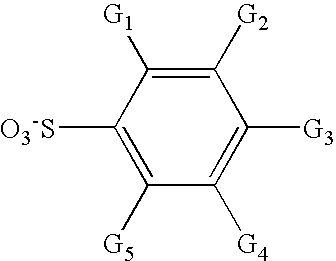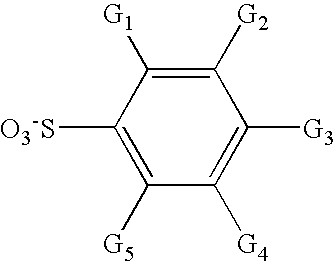Aromatic fluorine-free photoacid generators and photoresist compositions containing the same
a technology of aromatic fluorine-free photoacid generators and compositions, which is applied in the field of semiconductor manufacturing and optical lithography, can solve the problems of largely unsuccessful attempts to achieve performance comparable to formulations using pfos, and achieve excellent optical clarity, thermal stability and lithographic performan
- Summary
- Abstract
- Description
- Claims
- Application Information
AI Technical Summary
Benefits of technology
Problems solved by technology
Method used
Image
Examples
example 1
Synthesis of Silver 4-cyanobenzenesulfonate
[0043]To a solution of 4-cyanobenzenesulfonyl chloride (3 g, 14.88 mmol) in 50 mL of acetonitrile and 2 mL of water was added silver carbonate (4.1 g, 14.88 mmol) in portions in darkness. The resulting suspension was stirred overnight for 4 days, until no starting material is shown on the thin layer chromatography with an eluant of hexane / ethyl acetate (1:4). The mixture was filtered through half an inch of Celite® and the solid was washed with 3×50 mL acetonitrile. The organic filtrate was combined and organic solvent was removed via rotary evaporator to dryness and thus afforded 4.3 g of white solid with a yield of 99.6%. The resulting compound was not purified for further reactions. 1HNMR, d6-DMSO: 7.81 (d, 2H, 8.8 Hz), 7.75 (d, 2H, 8.4 Hz). 13CNMR, d6-DMSO: 152.60, 132.62, 126.91, 119.10, 111.73.
example 2
Synthesis of Triphenyl Sulfonium 4-cyanobenzenesulfonate. (TPSCN)
[0044]To a solution of silver 4-cyanobenzenesulfonate (1.16 g, 4 mmol) in 50 mL of acetonitrile and 2 mL of water was added a solution of triphenyl sulfonium bromide (1.373 g, 4 mmol) in 20 mL of acetonitrile and 5 mL of water. The resulting mixture was stirred overnight for 3 days and the solid was allowed to precipitate for 1 day before it was filtered. The organic solvent was removed via rotary evaporator and the residue was re-dissolved in 60 mL of 2-butanone. The resulting solution was washed with 3×10 mL of water, dried over magnesium sulfate and filtered though Celite® and aluminum oxide basic. The organic solvent wad removed via rotary evaporator and dried over vacuum oven to dryness and thus afforded 0.97 g of product with a yield of 55%. 1HNMR, d6-DMSO: 7.90-7.74 (m, 19H). 13CNMR, d6-DMSO: 153.11, 134.83, 132.54, 131.84, 131.74, 126.89, 125.62, 119.15, 111.50. DSC (10° C. / min, nitrogen 5 mL / min) showed no obv...
example 3
Synthesis of Tert-butylphenyldiphenyl Sulfonium 4-cyanobenzenesulfonate. (DPTBPSCN)
[0045]To a solution of silver 4-cyanobenzenesulfonate (1.16 g, 4 mmol) in 50 mL of acetonitrile and 2 mL of water was added a solution of tert-butylphenyldiphenyl sulfonium bromide (1.6 g, 4 mmol) in 20 mL of acetonitrile and 5 mL of water. The resulting mixture was stirred overnight for 3 days and the solid was allowed to precipitate for 1 day before it was filtered. The organic solvent was removed via rotary evaporator and the residue was re-dissolved in 50 mL of 2-butanone. The resulting solution was washed with 2×15 mL of water, dried over magnesium sulfate and filtered though Celite® and aluminum oxide basic. The organic solvent wad removed via rotary evaporator and dried over vacuum oven to dryness and thus afforded 1.55 g of product with a yield of 77%. 1HNMR, d6-DMSO: 7.89-7.73 (m, 18H), 1.32 (s, 9H). 13CNMR, d6-DMSO: 158.24, 153.12, 134.74, 132.53, 131.81, 131.71, 131.58, 128.89, 126.89, 125....
PUM
| Property | Measurement | Unit |
|---|---|---|
| wavelengths | aaaaa | aaaaa |
| wavelengths | aaaaa | aaaaa |
| temperature | aaaaa | aaaaa |
Abstract
Description
Claims
Application Information
 Login to View More
Login to View More - R&D
- Intellectual Property
- Life Sciences
- Materials
- Tech Scout
- Unparalleled Data Quality
- Higher Quality Content
- 60% Fewer Hallucinations
Browse by: Latest US Patents, China's latest patents, Technical Efficacy Thesaurus, Application Domain, Technology Topic, Popular Technical Reports.
© 2025 PatSnap. All rights reserved.Legal|Privacy policy|Modern Slavery Act Transparency Statement|Sitemap|About US| Contact US: help@patsnap.com



